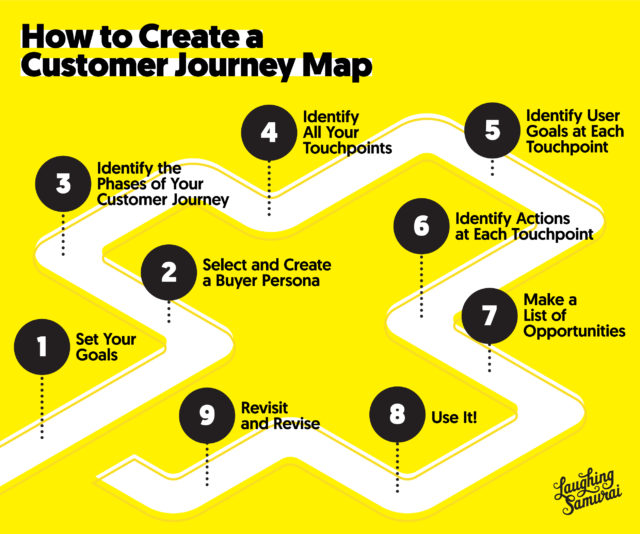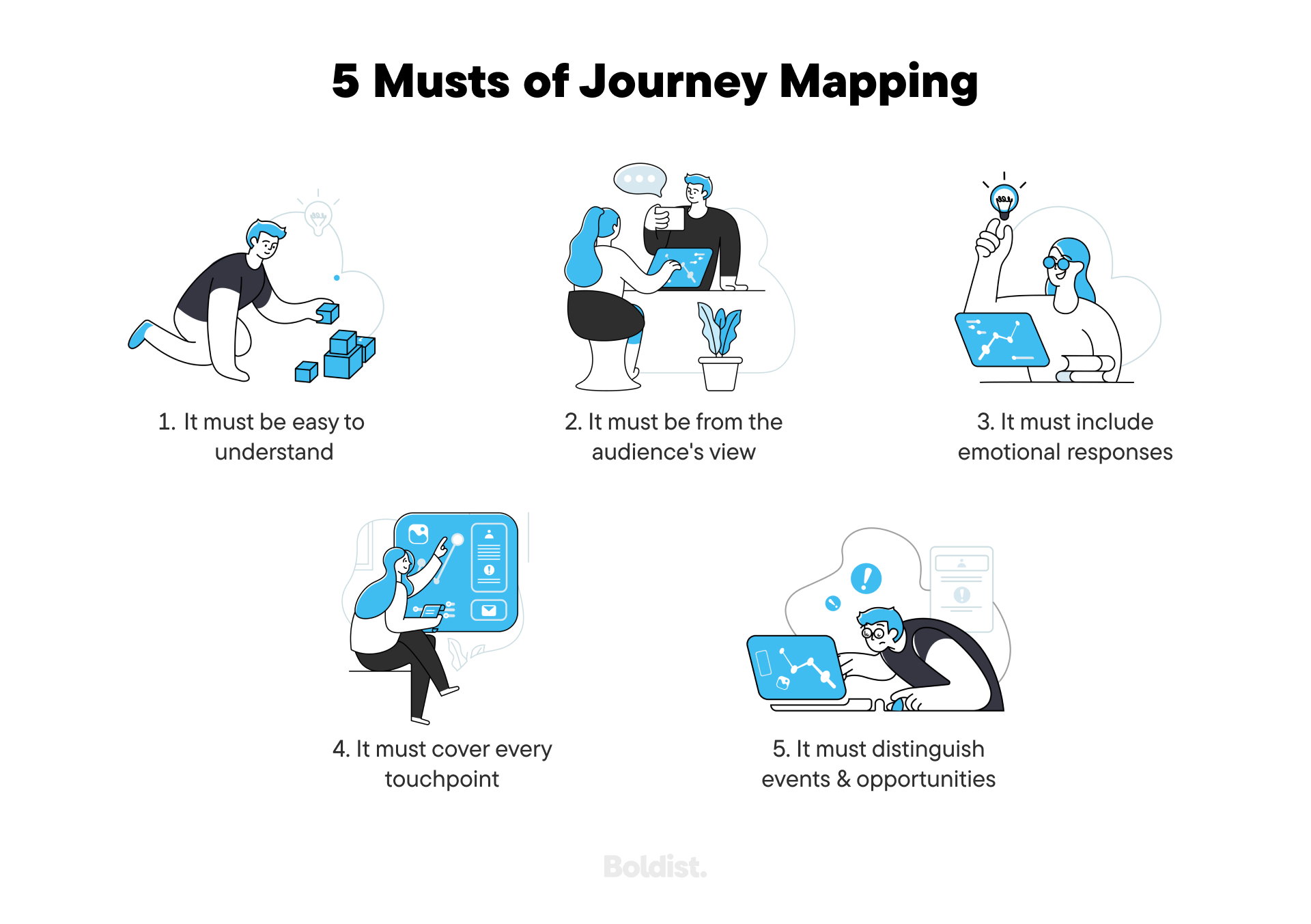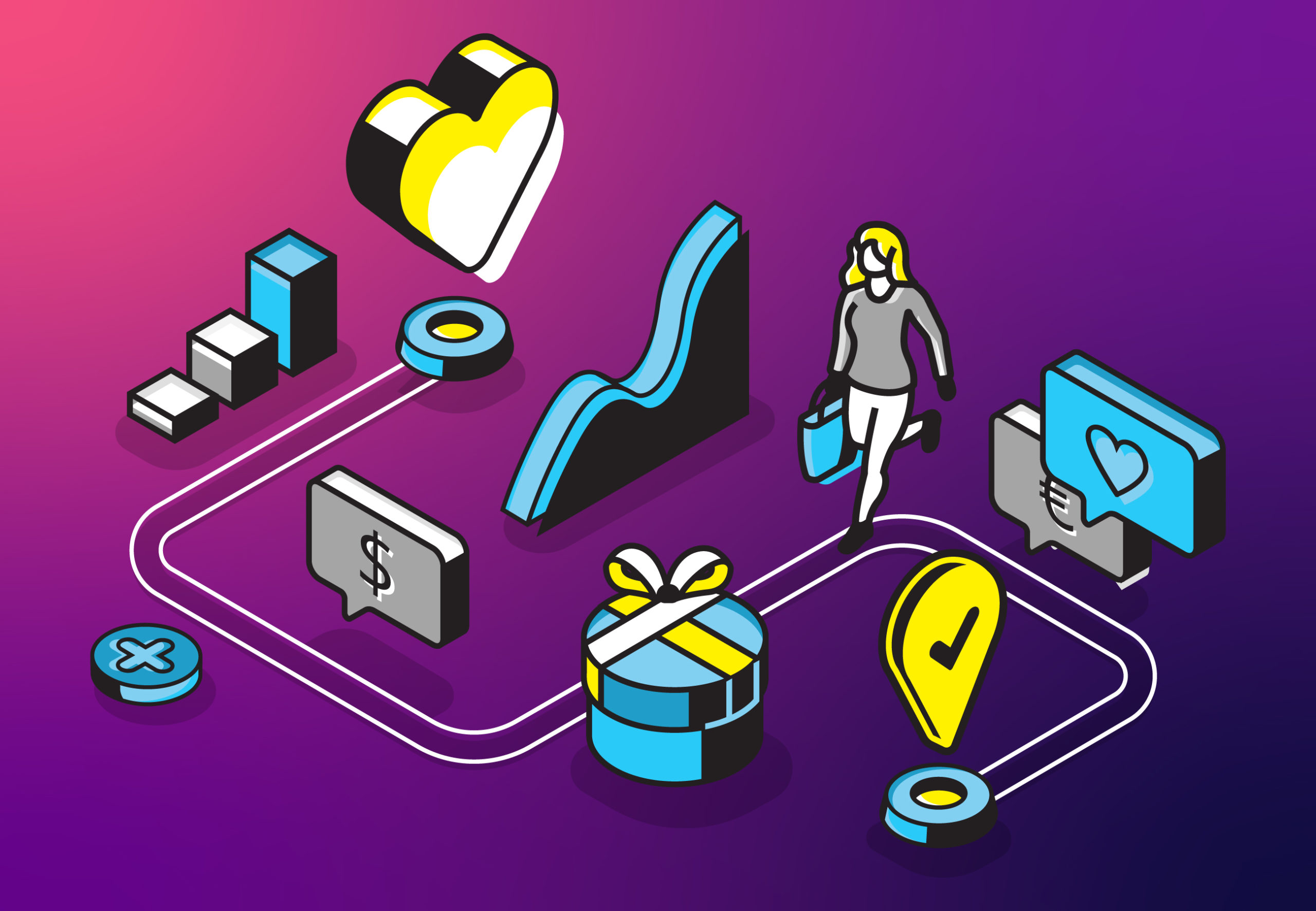We’ve already discussed why you need a customer journey map. If you don’t feel up to reading that article, consider these two statistics:
- Customer journey mapping results in a 54% greater return on marketing.
- Customer-centric companies are 60% more profitable.
These stats make sense because the point of customer journey mapping, or customer experience mapping, is to understand what your customers want, where you aren’t delivering and how to bridge the gap between expectations and reality. Naturally, this increases your conversion rates.
Convinced? Great.
Now, you’re probably wondering: “How do we make this thing happen?”
To be frank, the path to purchase is far from linear in the digital age. It makes journey maps a little more complex but all the more necessary.
Your journey map’s exact design and content will depend on your business and the product or service you’re mapping. This means you get to be creative and optimize your map just for you – who doesn’t love that?
Of course, there are still journey mapping best practices and steps to guide you.

1. Set Your Goals
A journey map without a purpose or goal is pointless. If you don’t create it with one in mind, it’ll become a confusing mess of information that you won’t know how to apply in the real world. Don’t waste your time with a map that doesn’t provide practical insight or tangible impact; set a goal and stay focused. Examples of goals you may have for your journey map include:
- Becoming customer-centered
- Assigning responsibility for touchpoints to departments
- Preventing abandoned carts
- Understanding a persona better
- Making an app more user-friendly
At this point, you’ll also want to define the scope of your map to inform how detailed or high level it will be. What’s needed to answer your questions thoroughly and accurately?
2. Select and Create a Buyer Persona
A key step in understanding your leads is creating personas for them. A persona is a representation of your customers made up of demographics and psychographics. You may have multiple personas based on your audience segments or where they are in the buying journey.
Once you’ve defined your audiences, you’ll want to choose one. Combining all personas into one map may provide too much information and result in ineffective strategies. You can always create a map for each customer persona later, but start with your predominant persona or the one that aligns with your goal.
3. Identify the Phases of Your Customer Journey
List every phase in the customer journey related to your goal; you may be working on a specific platform or evaluating the entire purchase journey.
Many companies use the standard steps of awareness, consideration, purchase, retention and advocacy, but you can make them unique to your business. A SaaS company may prefer to use discover, try, buy, use and seek support. The point is that a coffee shop and an ecommerce store are going to have different phases.
If you can, estimate a timeline for each phase.
4. Identify All Your Touchpoints
Your touchpoints are everywhere your audience interacts with your business, online or offline. Your touchpoints might include your ads, email, social media platforms, customer service interactions and website. You may even want to get specific – down to the landing pages or forms on your website.
Once you’ve listed all your touchpoints, assign them to the customer journey stages that they correlate to. And yes, they may belong to more than one.
With this, you can compare where your leads are going at each phase and where you want them to be. If there’s a difference between the two, it could be because it wasn’t clear where they needed to go.
A good strategy for your website is to take advantage of the Google Analytics Behavior Flow report. It will show you how your website users move from page to page and is a great way to identify your page touchpoints, the sources that lead to your website (possibly more touchpoints) and their sequences.
5. Identify Customer Goals at Each Touchpoint
Now, take the time to identify your customers’ goals at each touchpoint. Understanding their motivations will help you give them what they want.
And, with an understanding of their expectations, you can exceed them. Take the example of a pizza delivery: A customer may expect their pizza to arrive in 20 minutes, but if you can get it there in 10, you just created a memorable customer experience. That is assuming everything else, from taste to packaging, met or exceeded expectations as well.
Your audience’s motivations may change between personas and depend on the phase of the journey they’re in.
6. Identify Actions at Each Touchpoint
After making a note of customer goals, fill out the map with customer actions at each touchpoint and phase.
You can also use the Google Analytics Behavior Flow and Goal Flow reports to help here. The Goal Flow report will show you the path your visitors take (in other words, the actions) to complete a goal conversion. Where do they drop off? Do they go through unwarranted loops?
To get the most out of your experience map, make a note of their emotions as well. What feelings did they arrive with, and how do they feel during and after interacting with your brand?
This will arm you with the knowledge to instigate positive feelings and identify where actions and goals are contradictory. If a user takes the wrong step towards their goal, you’ve identified a friction area that could be due to bad information architecture.
7. Make a List of Opportunities
Congrats! You’ve made it to our favorite part: identifying opportunities. It’s time to learn from everything you’ve accumulated.
What are your customers’ pain points? Where do they get lost and confused? Where do they hesitate? Where do you fail to meet – or surpass – expectations? Where are you successful? Where do you earn raving reviews, high conversion rates or shortened task times?
Make a note of all obstacles and everywhere you want to improve on your journey map.
8. Use It!
So you know where you can do better; the next step is actually doing it. The point of making your map was to uncover implementable insight, so implement it. Assign improvement tasks to specific individuals or departments. Have everyone review the map, understand it and use it in daily practice.
Whether you update whole product flows or tweak small areas, be sure to step back and see how it all flows together. You want to make sure every change fits and contributes to a seamless experience.
You may need new investments or tools to make changes happen, but that’s part of running a growing business. The good news is that a well-made map will make it easier to get management on board.
9. Revisit and Revise
We see you trying to wrap a pretty little bow on that project and call it a day, but we’re not done with you. One of the most vital elements of a journey map is that you continue to re-evaluate it. Your business, customers and industry are always changing. Revisiting your customer journey is necessary to meet new expectations and foster growth.
Pick usability metrics to monitor, from customer satisfaction to task completion rates. Regularly test to discover new areas to improve, and update your journey when it’s time.
5 Musts of Journey Mapping
There are five must-haves for every journey map that are easy to miss or forget:
- It must be presented in a way that everyone can visualize the journey. If they can’t understand it, they can’t use it.
- It must be from your audiences’ perspective. They’re the ones taking the journey and the only ones who matter.
- It must combine emotional response with tasks. It’s how you provide a positive user experience that they’ll remember.
- It must focus on the journey across multiple touchpoints. The customer doesn’t distinguish between touchpoints when thinking of the brand experience, and neither should you.
- It must differentiate between future opportunities and current experiences. Don’t miss out on growth because of a disorganized map.

A Brief Note on the Types of Journey Maps
There are different types of journey maps, and the one you use will depend on the goal you settle on in the beginning. The nine steps above are for creating a current state customer journey map – the most common type.
Still, all three of the main types will primarily follow the above process. The main difference will be for a day in the life map where you’ll list the persona’s daily activities instead of your touchpoints.
Current State Journey Maps
Your standard map, current state maps analyze what your audience currently experiences while interacting with your business. Use this form of customer journey analysis to improve the journey.
Day in the Life Journey Maps
Day in the life maps are the most different as they analyze what your audience experiences throughout their daily activities regardless of your company. Use these maps to discover pain points in your audiences’ life so that you can address unmet customer needs before they ask. It can be a great way to realize new products.
Future State Journey Maps
As the name suggests, future state maps estimate what your audience’s experience of your business will be in the future. They can help bring your vision to life or allow you to map out where you want to go based on a current state map.
Can You Walk in Your Customers’ Shoes?
You’ll find many explanations on how to create a customer journey map that say to take the customer journey yourself – to walk in their shoes. You can do this to familiarize yourself with your customer journey or if you don’t have the time to involve others, but any journey map based on your experience of “walking in their shoes” will be limited in insight and accuracy.
You’re too close to your own projects to see them without bias. You know how you want leads to perceive the experience, so you’ll perceive it that way. You know how your products work, so it will be different for you than for a user with no prior experience.
And then there’s the false-consensus effect where everyone tends to assume that others are more like themselves than they are – that they’ll think the same things or act in the same ways.
These are all reasons why you need research to show how your audience actually experiences each touchpoint to make your journey map valid. If you can’t access real customers, you can even work with customer service representatives who interact with them and their troubles daily.
You may want to do research at the beginning to determine a goal or define a persona, in the middle to uncover user flows and feelings, or at the end to reassess your map. If you’re unsure where to start, check out our complete guide to UX research methods. There are options for limited budgets to large projects.
On Bringing Your Map to Life
From digital spreadsheets to the artistically drawn poster, you can create your map the way that works best for you, your company and your employees. In our experience, crafting a visually compelling story works best because it’s exciting to read and easy to apply.
Many customer journey mapping tools can help you build an attractive and effective map. Just be sure to create clear phases for your journey, and make it painless to identify the audience questions, goals, actions and emotions under each. And always take that extra step to list out what your opportunities are, what needs to be done to bring them to life, and who needs to do it.
When to Create a Customer Journey Map
When to make a journey map will depend a lot on your company and the complexity of your journey. A good standard to aim for is to revisit and update your map every six months.
There are instances, though, where changes or events may move that timeline up or spur the creation of a new map. These include introducing a new product or service, answering a question that arises or striving to meet a new goal.
If your map seems overly complex or you’re overwhelmed at the idea of having to revisit it, review these tips for simplifying your customer journey map.
Join the Success Club
Customer journeys have become more elaborate, making journey maps more vital than ever. Unlike many business trends, customer journey maps will remain valuable no matter how the times change. Regardless of technology advancements or industry shifts, a journey map can always adapt to provide the customer experience that will convert.
So now that you know how, go ahead and reap the benefits. If it sounds like a lot of work or you’re unsure where to start, reach out.


